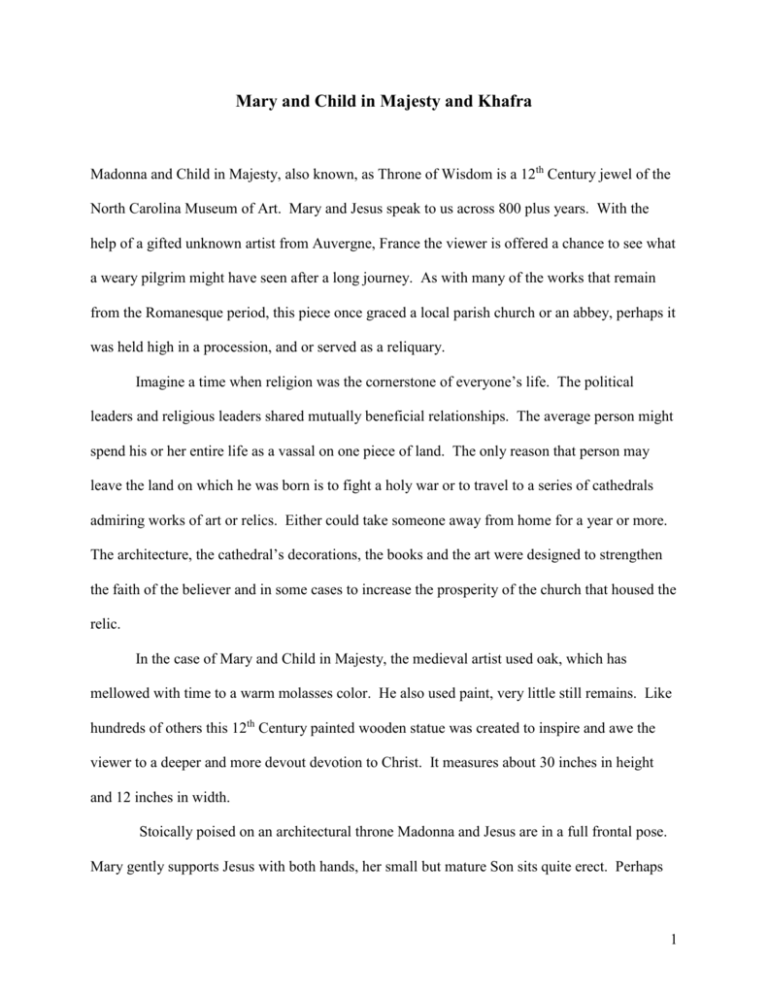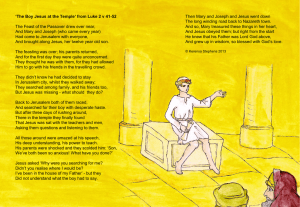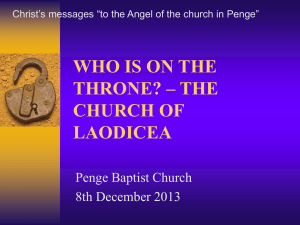Imagine that you are an art historian who has agreed to write an
advertisement

Mary and Child in Majesty and Khafra Madonna and Child in Majesty, also known, as Throne of Wisdom is a 12th Century jewel of the North Carolina Museum of Art. Mary and Jesus speak to us across 800 plus years. With the help of a gifted unknown artist from Auvergne, France the viewer is offered a chance to see what a weary pilgrim might have seen after a long journey. As with many of the works that remain from the Romanesque period, this piece once graced a local parish church or an abbey, perhaps it was held high in a procession, and or served as a reliquary. Imagine a time when religion was the cornerstone of everyone’s life. The political leaders and religious leaders shared mutually beneficial relationships. The average person might spend his or her entire life as a vassal on one piece of land. The only reason that person may leave the land on which he was born is to fight a holy war or to travel to a series of cathedrals admiring works of art or relics. Either could take someone away from home for a year or more. The architecture, the cathedral’s decorations, the books and the art were designed to strengthen the faith of the believer and in some cases to increase the prosperity of the church that housed the relic. In the case of Mary and Child in Majesty, the medieval artist used oak, which has mellowed with time to a warm molasses color. He also used paint, very little still remains. Like hundreds of others this 12th Century painted wooden statue was created to inspire and awe the viewer to a deeper and more devout devotion to Christ. It measures about 30 inches in height and 12 inches in width. Stoically poised on an architectural throne Madonna and Jesus are in a full frontal pose. Mary gently supports Jesus with both hands, her small but mature Son sits quite erect. Perhaps 1 Madonna has an ever so slight smile on her lips but her gaze is steady. They each share a serious expression that encourages soul searching. Their faces are representational but their bodies are somewhat abstract which suggests a sense of other worldliness. Mary, Theotokos (God bearer) who was becoming more prominent during this time, wears a hood that is created with multiple rows of incisions that create lines and grooves coming toward her face. Her cap is close to her head with just a few bangs framing her face. The headpiece appears to be separate from her clothing but the stylized folds of the fabric match as if it were all one piece of fabric. Her face’s smooth complexion is rigid with perfectly proportioned eyes, nose and mouth. She has a slightly heavy brow, maybe in lieu of eyebrows. Though literally her eyes are blank there is intensity despite no pupil or iris. (As mentioned earlier the piece was originally painted, perhaps originally there was eye color.) Her eyelids are creased. Her nose is perfectly straight above lips that are ever so slightly turned upward. The feeling of the overall expression is certainly solemn. Her cheeks are full but not overly extended outward. Her chin disappears into shade. Her draped clothing begins at her throat with “U” shaped symmetrical stylized folds continuing down her torso to her waist, which is mostly obscured by the young Jesus. The patterns of the fold are in the opposite direction over her arms and legs. Mary has oversized hands with very straight fingers. Her right hand supports and protects Jesus at his waist, her left hand rests across their left knees. Mary’s two shoes are exposed underneath the floor length garments. From the sides the viewer will see that Mary sits almost all the way back on her seat but not resting against the back of the throne. Likewise while the throne is created in such a way as to provide armrests, Mary does not rest her arms. In short her position in the chair matches her 2 facial expression, stiff, solemn and regal. In her upper back a small hole is visible and is the indication the piece was used as a reliquary. Mary sits on an architectural throne. Its double horizontal braces are supported and separated by four Romanesque columns. This throne is believed to symbolize the throne of Solomon. Jesus is considered to be a philosophical descendant of Solomon; his earthly family is also a literal descendant of Solomon. The assumption this throne represents the throne of Solomon is really a traditional belief. There is nothing in the actual throne itself to indicate it is Solomon’s throne or a Throne of Wisdom. The throne rests on a stone slab that could be granite. Mary serves as the throne for young Jesus. One might say she is his human connection with the throne of wisdom. He is God and He is human. His divinity is expressed in his mature appearance. His humanity is expressed in the fact he’s about the size of a three year old. He is poised upon her lap with an unnatural and rigid pose. His head is slightly oversized for his body. On his head is a very short haircut with what appears to be a receding hairline. His high forehead, large eyes, and ears portray a Jesus that gazes out at a world with a serenity and wisdom. Though there are no eyebrows incised into the wood, the appearance of eyebrows is in the heaviness of the forehead. The eyelids are creased. His eyes have real and natural appearance though there is no color and no carving to reflect an iris or pupil. Like his mother, the young Jesus clothes are undefined drapes with a jewel neckline that appears to have a vertical placket in the middle of his chest. On his right, the viewers left, the pattern is like his mothers, a “U” shaped fold that descends to his upper waist. On his left the pattern is straight vertical. There appears to be a cummerbund around Jesus waist. His left hand, also oversized, palms the top of a book, presumably the Bible, or Word of God. His right hand is missing but it is believed 3 it would have been raised in a blessing. His tiny bare feet mostly covered by the robes are situated at the top of Mary’s shins. The woodcarving is compelling and serene. Certainly the 12th Century believer would have felt the power in the piece. 1200 years after his death this type of piece was duplicated again and again. People wanted the opportunity to gaze upon a man-made object that connected them to their Savior. The fact there are multiple renditions of the Madonna and Child in Majesty does not diminishes the power of that individual work of art to inspire an individual Christian to a more devout life. In many ways Jesus, a spiritual leader, shares much with Khafra (Stokstad p.65 3-11), a political leader. They both have a strong sense of the after life. They both are concerned with immortality. Khafra is concerned with his own. Jesus is concerned with the immortality of His believers. Both are honored with sculptures. 3700 years before Christ and 5000 miles away statues were hewn to perpetuate the memory of Khafra who also was believed to be part god and part man. Khafra was immortalized. Unlike the millions of statues and paintings of Jesus created after his death, Khafra commissioned his own likeness multiple times, the largest of which is the Great Sphinx. Unlike the carved oak of Mary and Jesus, Khafra’s likeness is made of diorite stone, a very hard stone that actually changes color to a deep blue (color of god Horus) in the sunlight. There is also a remarkable difference in size. Jesus is no more than twenty inches upon his mother’s lap. Khafra measures just over 5’6” from his seated position, decidedly over sized. Also both Jesus body and clothes have a timeless quality. Khafra wears the traditional royal costume of his time and place. Khafra’s has an ideal body. He has wide shoulders and a muscular chest, smoothly chiseled arms held tight and close near a small waist. 4 However, there are strong similarities. The most obvious is the fact that both sculptures are designed to create a sense of dignity and calm, while inspiring the viewer to greater sense of awe. The expressions on their faces are very similar. There is intensity in the carved eyes and slightly upward turned lips and certainly an assurance that the subject of both these statues have any situation “in-hand”. In the case of Mary and Jesus, Mary, who is actually human, protects Jesus with her arms around him, Khafra is protected by the falcon god Horus who is perched on the back of the throne with his wings wrapped around the Pharaoh’s head. In both cases their thrones are representational. Khafra’s throne has lion’s feet for the throne legs that symbolize strong authority. Under his seat of power are lotus and papyrus plants demonstrating his control of Upper and Lower Egypt. Jesus’ throne is Mary who represents his humanity; her throne is the seat of wisdom. Both pieces are beautiful and powerful to the people of the time. They instilled such awe in the viewer. 5









